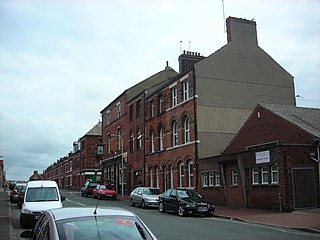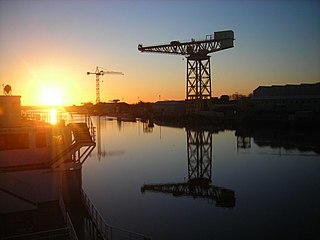
Ramsden Dock is one of the four docks which make up the Port of Barrow in Barrow-in-Furness, England. It was constructed between 1872 and 1879 covering 162,000 square metres (1,740,000 sq ft) and named in honour of Sir James Ramsden; a founder of Barrow. [1] Ramsden Dock splits into two parts in the south, the anchor basin and dock basin. Since the infilling of a section of Devonshire Dock in the 1980s, Ramsden Dock has been the only point of entry to Barrow's now enclosed port. [1] Managed by Associated British Ports, Ramsden Dock is by far the busiest of the four dock in terms of cargo tonnage, handling shipments of limestone, sand, aggregates and granite. [2] Ramsden Dock and the Port of Barrow as a whole are highly involved in the energy sector and the nearby Rampside Gas Terminal, Sellafield nuclear facility and offshore windfarms. [2] The port office is located adjacent to Ramsden Dock. [2] Powerboat racing often takes place in Ramsden Dock, while a proposed redevelopment scheme of the area incorporates a watersports centre within the dock. [3]

The Port of Barrow refers to the enclosed dock system within the town of Barrow-in-Furness, England. Morecambe Bay is to the east of the port and the Irish Sea surrounds it to the south and west. The port is currently owned and operated by Associated British Ports Holdings, but some land is shared with BAE Systems Submarine Solutions. Currently consisting of four large docks, the Port of Barrow is one of North West England's most important ports. The docks are as follows: Buccleuch Dock, Cavendish Dock, Devonshire Dock and Ramsden Dock. The port of Barrow is the only deep water port between the Mersey and the Clyde.

Barrow-in-Furness, commonly known as Barrow, is a town and borough in Cumbria, England. Historically part of Lancashire, it was incorporated as a municipal borough in 1867 and merged with Dalton-in-Furness Urban District in 1974 to form the Borough of Barrow-in-Furness. At the tip of the Furness peninsula, close to the Lake District, it is bordered by Morecambe Bay, the Duddon Estuary and the Irish Sea. In 2011, Barrow's population was 57,000, making it the second largest urban area in Cumbria after Carlisle, although it is geographically closer to the whole of Lancashire and most of Merseyside. Natives of Barrow, as well as the local dialect, are known as Barrovian.

Devonshire Dock is the oldest of the four docks which make up the Port of Barrow in Barrow-in-Furness, England. Although the dock falls under the control of Associated British Ports it is currently solely utilised by BAE Systems. Upon completion of the dock, Prime Minister William Ewart Gladstone stated 'Barrow would one day become another Liverpool'. Although it's shipbuilding capabilities have exceeded those on Merseyside, the port and dock system itself never fully met James Ramsden's grand vision for the town.
Historically, Ramsden Dock was a major transportation hub with a dedicated railway station connected to a branch of the Furness Railway and a terminus of the Barrow-in-Furness Tramway. A passenger ferry terminal at the dock was utilised by the Isle of Man Steam Packet and Barrow Steam Navigation Company offering steamer services to the likes of Belfast and Douglas, Isle of Man. [4] A rail line along the eastern perimeter of Ramsden Dock remains in use to this day with freight services to and from the dock.
Ramsden Dock railway station was the terminus of the Furness Railway's Ramsden Dock Branch in Barrow-in-Furness, England.

The Furness Railway (Furness) was a railway company operating in the Furness area of Lancashire in North West England.
The Barrow-in-Furness Tramways Company operated a tramway service in Barrow-in-Furness between 1885 and 1932.













